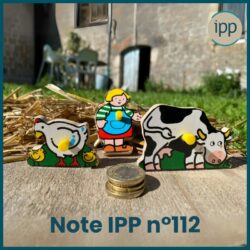> Read the note
Quote. Price floors in the agri-food industry: a measure of efficiency? IPP Policy brief n°112. Rémi Avignon, Etienne Guigue. December 2024.
Presentation
The idea of introducing price floors in agricultural sectors has recently resurfaced in public debate. A flagship measure of the Common Agricultural Policy (CAP) of the 1970-1980s, price floors proved to be a source of inefficiency and left bad memories behind. This note shows, however, that a price floor on raw materials can be efficient in sectors where farmers face buyers with monopsony power,—namely when buyers can negatively influence prices.
Key results
- Whereas a price floor imposed in a competitive market is necessarily inefficient, a price
floor on raw material can be efficient in sectors where farmers face monopsony power. - In the cow milk sector (not labelled organic or Protected Designation of Origin), authors show
that French processors exercise monopsony power when purchasing raw milk, bought at
a price that is 16% lower – on average over the period 2003-2018 – than its marginal
contribution to their profits. - In such sectors, a price floor indexed to international agricultural commodity prices and
integrating processor manufacturing costs would lead to better remuneration for farmers
and a reduction in the processor and distributor margins. - The introduction of an efficient price floor could nevertheless destabilise a sector in the
short run and reinforce the concentration at the processing level in the long run, making
its effect on consumer prices uncertain. - The farm income support provided by a price floor alone is limited by international competition.
It can be supplemented by agricultural supply support measures (subsidies, trade policy) whose efficiency is enhanced, the price floor preventing such support from being captured by players further down the supply chain. - A price floor indexed to international prices would not allow farm income smoothing,
which could be achieved by introducing an insurance scheme.
> Read the note
Method and data
The analysis is based on data at dairy processing plant level, where raw milk prices and quantities by department on the purchase side, and by product on the sales side, are observed from 2003 to 2018. Data are provided by the Ministry of Agriculture (Enquête Annuelle Laitière), FranceAgriMer (Enquête Mensuelle Laitière), and the Ministry of Public Finance (FICUS, FARE, LIFI). Access to some of the data used in this work was provided within the secure environments of the Centre d’accès sécurisé aux données – CASD (Ref. 10.34724/CASD). The authors restrict the analysis to products made from cow’s milk not bearing the organic or PDO label. Margins are estimated in two stages: (1) Estimation of processing costs and margins
A “production function” approach, standard in the literature (De Loecker andWarzynski, 2012), enables us to estimate the marginal cost of processing raw milk into finished and industrial products for each company. Combined with data on fat and protein content in raw milk and in each dairy product (Depeyrot, 2010), and on prices and quantities, this method enables us to estimate the variable cost margins of dairy manufacturers. (2) Separate identification of monopsony and monopoly margins
The existence of dairy ingredients then enables us to separately estimate monopsony margins, known as markdowns, and monopoly margins, known as markups. Identification is based on the fact that these ingredients are:
– substitutes for raw milk on the purchasing side, and alternative outlets for finished products on the sales side,
– traded at a price that companies consider to be given. Identification is therefore based on the arbitration conditions applied by manufacturers in their decisions to purchase raw milk or ingredients, on the one hand, and to produce and sell finished products or ingredients, on the other. In equilibrium, companies using ingredients equalize the price of ingredients (observed) with the marginal costs of sourcing raw milk (made up of the price of milk, observed, and the opportunity cost inversely linked to the markdown, unobserved). Symmetrically, companies selling ingredients equalize the ingredient price (observed) with the marginal net revenue of each finished product (composed of the price of the finished product, observed, and the opportunity cost or markup, unobserved). These arbitrage conditions enable markdowns and markups to be identified separately.
Acknowledgements
This note was supported by the Agence Nationale de la Recherche (Programme Investissements d’Avenir, ANR- 18-EURE-0005), the ERC Consolidator Grant 816638 awarded to Jan De Loecker, and INRAE.
Reference study
Avignon, Rémi and Etienne Guigue (2023). Markups and Markdowns in the French Dairy Market. Tech. rep.
Ce message est également disponible en :  French
French



